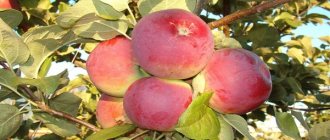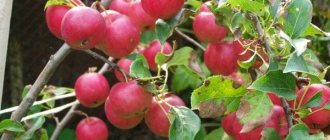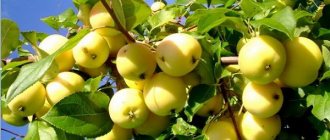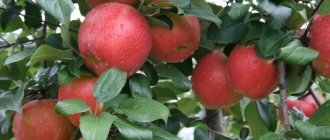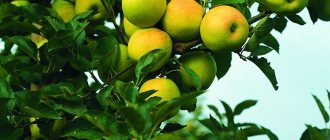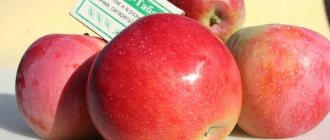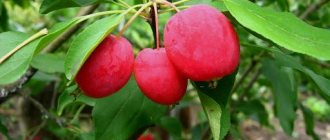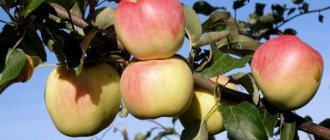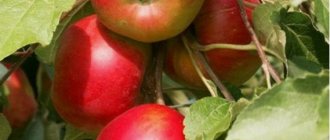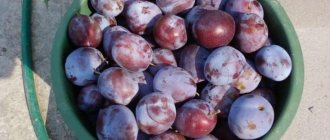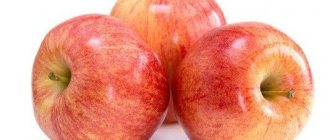Description
The Banana apple variety is a Belarusian representative of winter ripening. Nice large fruits have a bright yellow peel, a persistent aroma and a pleasant taste.
The tree is medium in size, with a rounded crown and dense branches. The leaves are dark green in size, with a glossy plate and a bluish coating below. Growth rates are average, but the crown is prone to thickening.
The variety is immune and has good resistance to scab and other diseases of fungal origin. High immunity helps to resist other diseases. Pests rarely attack fruit crops. Growing is quite simple, without any problems or features.
Shipping and payment
The minimum order amount on our website is 1000 rubles.
Valley of Plants values and respects every customer, and therefore strives to do everything to ensure that cooperation with us is as profitable and enjoyable as possible. Now you can order our seedlings and plant seeds from any corner of Russia. All planting material is provided with a quality guarantee.
We work without prepayment - payment for the order upon receipt!
Stages of distribution of planting material “Spring 2020”:
– from January 15, 2020
: vegetable and flower seeds
(if the order contains only seeds a )
.
– from March 1 to April 30, 2020
: bulbous plants, roses, fruit trees and shrubs, related products.
Characteristics of the variety
The banana variety apple tree can be considered a typical winter representative. All characteristics and photos confirm this.
Characteristics of fruit and tree
You can get to know Banananov better by considering a number of characteristics and features of the variety.
Among them:
- the rate of early fruiting is average, the first fruits can be collected 5 years after planting;
- removable fruit ripening occurs in September, consumer ripening occurs in December;
- abundant fruiting can be disrupted only due to overload of the crop;
- the yield is also average, up to 70 kg from a small tree;
- fruits hold firmly on the branches and do not fall off;
- convenient height of the apple tree, which makes it easier to care for;
- resistance to low temperatures is average and even above average with proper care;
- good immunity, but in high humidity you will need protection from scab;
- consumer qualities are preserved for a long time and can withstand transportation;
- excellent shelf life of fruits, until the next warm season;
- pleasant-tasting fruits with a high tasting score.
The variety was bred and released in Belarus, but has recently become widespread in neighboring countries.
Advantages and disadvantages
Probably, after all the listed characteristics, it is difficult to add to the list of positive aspects of the variety. Apples are beautiful, tasty and juicy, last a long time, and can be used universally for making compotes and jams. The tree itself is unpretentious, grows moderately and gets sick only in the most rare cases.
Ripe apple fruits.
At the same time, practically no shortcomings of the variety were noticed. Just a few nuances. In order for the apples to have enough sunlight, it will be necessary to thin out the crown: thickening will negatively affect the harvest.
There is a need to normalize the amount of fruit. If one year there is a surplus of crops, then the next year there may be none at all. And even distribution of the load will help make fruiting annual.
The fruiting period of the variety is not so long, which can also be considered a disadvantage. After 15 years of stable fruiting, the apple tree begins to age and bear fruit very poorly. Due to its unprofitability, it is cut down.
Pollinators
The Banana variety is not self-fertile and requires cross-pollination with other apple trees. There are no special requirements for what exactly the neighboring pollinator variety should be, the only important thing is that it blooms at the same time.
Productivity
Although the amount of harvest is not the largest, the figure of 50-70 kg is quite an excellent result. The apples themselves are large and liquid. It is important to ensure that there is no frequency of fruiting. After 15 years of fruit production, the yield decreases.
Apple tree just before harvest.
Pros and cons of apple tree Banana
The variety has a number of advantages, thanks to which it becomes the choice of many gardeners:
- The fruits are very large and sweet. They can be used for making juices and jams or eaten fresh. Apples tolerate heat treatment well and do not lose their taste.
- High yield. If the growing rules are followed, the maximum yield is observed 5-6 years after cultivation. In the future, the number of fruits may decrease slightly.
- Good keeping quality. Unlike other summer varieties, apples have a hard skin and almost never spoil. Therefore, they can be stored throughout the winter. In addition, the fruits tolerate transportation well over long distances and have a marketable appearance. But it is recommended to store them in the basement or in the refrigerator. By spring, the taste may deteriorate slightly, so it is recommended to eat apples before winter.
- Winter hardiness. The tree does not freeze, even if it is not protected from frost. If some branches become damaged, they will simply need to be pruned in the spring.
- Drought resistance. The plant tolerates summer heat. But sometimes it is recommended to water it.
- Resistance to diseases and pests. The plant is rarely susceptible to the development of scab and other diseases. But for prevention, annual spraying with special compounds is recommended.
- Unpretentiousness. The plant tolerates any weather conditions well, does not die and does not reduce yield due to temperature changes.
See also
How can you mulch an apple tree, organic and inorganic materials, mown grassRead
The plant has almost no flaws. Unless already ripe apples have to be picked by hand, since they do not fall off, as happens with other varieties. In addition, the apple tree begins to bear fruit poorly 15 years after planting. Therefore, growing it in the future is unprofitable.
Features of planting and care
The variety is completely unpretentious. But it needs to be planted correctly to set the pace and strength of growth. Care conditions and cultivation are also quite simple. It is necessary to choose the right planting material, place and timing.
Landing rules
You need to choose the right time depending on the planting region. If you place a Banana apple tree in the ground in the northern regions, which have severe frosty winters, then it is better to do this in the spring. The date should be chosen at the end of April or even the beginning of May, when the cold has already passed and the buds have not yet bloomed.
In the southern regions, Banana seedlings can be planted before winter. Planting can be done from September to mid-October. Over the winter, the seedling will take root and begin to actively grow in the spring.
Selection of the best seedlings
An important condition for normal cultivation is the correct choice of planting material. You need to inspect it carefully before purchasing.
Apple tree seedlings.
It is important to adhere to certain requirements:
- You need to buy one- or two-year-old seedlings. They usually have no more than three side shoots.
- The leaves should not open.
- There should be no growths or dry damaged areas on the roots.
- The barrel must be elastic, without mechanical damage.
- The wood under the bark should be bright green.
It is important to make a purchase in a trusted place: in a nursery or in a special market. Then you can be sure of purchasing a real varietal sample.
Selecting a location
Comfortable growing conditions must be provided even before planting, at the stage of choosing a location. There are a number of requirements that need to be taken into account: the place must be well lit, protected from gusts of cold wind and drafts.
It is best for the soil to be light and loose, preferably loam or chernozem. You also need to make sure that the area is level and that moisture does not accumulate there.
A hole for planting an apple tree.
Planting scheme
The normal distance to other trees when planting is 5 meters. There should be about 4 meters between rows. Then the crown will have enough space and light.
The planting technology is simple:
- Prepare the planting hole in advance and add fertilizer to it.
- Make drainage at the bottom using small stones and broken bricks.
- Make a hill from the previously prepared soil and drive a support in the center.
- Install the seedling and carefully straighten the roots.
- Cover with soil and compact.
- Water and mulch the tree trunk circle.
This is enough for the apple tree to quickly grow. But when planting in the fall, you cannot add nitrogen elements to the planting hole, so as not to stimulate growth in winter.
Watering and fertilizing
In order for the fruits to fill with juice, they need regular watering. A sufficient amount of moisture will help the plant protect itself from pests and diseases.
Fertilizing the apple tree in spring.
There are several general rules for watering crops:
- Young seedlings need 20 liters of moisture at the root every 3 weeks.
- Adult apple trees are watered 3-4 times per season.
- You need to add moisture little by little, at the root, so that it has time to be absorbed and not wasted.
- The apple tree responds well to leaf irrigation.
Timely fertilizers will help maintain the health of the apple tree. They also need to be carried out according to a schedule:
- in the spring, organic matter is added at the root and copper-containing preparations are added to the buds;
- nutrients are added during flowering;
- during the period of ovary formation, another fertilizer is applied;
- if desired, you can feed the apple tree before the fruit ripens;
- in the fall, in order to restore strength and prepare the plant for winter, you need to add organic matter to the tree trunk.
In summer you can spray the crown with mineral fertilizers.
Trimming methods
To form a crown of the correct shape, pruning is carried out. It is combined with sanitary to maintain the health of the apple tree.
There are several types of this procedure:
- thinning shoots that thicken the crown and interfere with the fruits;
- shorten too long shoots that get out of the general crown;
- sanitary removal of old dried branches, broken and damaged.
Apple tree pruning diagram.
The procedures should be carried out in two stages: autumn and spring. Spring pruning is carried out to form the crown of the desired shape. The first procedure is carried out the same year after planting. The central conductor is cut to stimulate the growth of lateral branches. The grown branches on the sides are also cut off, forming a tiered scheme.
In the fall, after the harvest and the leaves fall, the procedure for sanitary pruning of the apple tree is carried out. Then you can clearly see the places of damage that need to be cut off. It is important to carry out the procedure with a sharp knife and cover the wounds with garden varnish.
Whitewash
Whitewashing carried out in spring and autumn will help protect the apple tree from burns, frost damage, pests and diseases. It can be carried out with a special purchased solution or prepared independently from clay, lime and glue. You need to add a little fungicide to the solution to kill pests.
It is important to use a freshly prepared solution. The consistency should be similar to thin, low-fat sour cream. The trunk and the base of the skeletal shoots are whitened.
Preparing for winter
The Banana variety can easily survive frosts of -25 degrees. But lower indicators are already potentially dangerous for them. However, this only applies to adult cultures.
Young seedlings need maximum shelter. The tree trunk circle needs to be hilled up, mulched with peat and sawdust. The trunk is wrapped in paper or burlap and covered with spruce branches on top. You can even put a bag on young trees and secure it.
After snow falls, it is piled up as much as possible to make the insulation even more dense. In spring, the shelter is unwound and opened so that high humidity does not destroy the roots of the plant.
Banana Tree Care
For better development, a banana needs a lot of air, but at the same time, both cold drafts and stuffy, stale air from an unventilated room are harmful to it. Therefore, if the owner provides the pet with regular ventilation without drafts, this will have a very beneficial effect on the plant itself.
How to water a banana tree?
In order not to kill the plant, you should know not only how many times you need to water a banana, but also how the quality and volume of irrigation water varies throughout the year and the phases of development of a giant blade of grass. A false banana trunk has a negative attitude towards allowing moisture to enter and stagnate inside it. On the contrary, the “leaves” suffer from dry air. Any bananas cannot tolerate stagnation of water in a tub, but its deficiency or uneven supply can lead to very early ripening of underdeveloped fruits or their shedding. Therefore, during the warm period, bananas are watered once every 7-9 days, and in winter once every 14-21 days. It is difficult to determine the volume of water for irrigation at one time, but it is possible. It is necessary to pour until the first drops of liquid appear in the pan. The water temperature should match the air temperature.
The leaves are wiped with water - every day in the summer, in the evening, and in extreme heat in the morning. But in winter, the leaves are only sprayed, until they are wetted, once every 2-3 days. The quality of the water itself should be as close as possible to soft water and in no case contain chlorine.
Banana tree during flowering
Has the banana tree bloomed? Home care should focus on proper nutrition and watering, otherwise it will shed all the ovaries. And after the last banana is collected, the entire above-ground part must be cut off (without waiting for natural death) and the pot with the rhizome should be placed in a dark and slightly cool place (+ 18 0 - +23 0) with watering once a week. Then a replacement shoot will appear from the dormant bud and the cultivation will be repeated all over again.
How does a banana tree reproduce?
For propagation, divisions of rhizomes with roots, just a division of a bud with a large part of the rhizome, or “tuberous” buds with rudiments of roots are suitable. Some types of indoor bananas can also reproduce by seeds, but often such plants have inedible fruits. The cut area should be sprinkled with either crushed activated carbon or lubricated with garden varnish. The time from transplanting the rooted cuttings to harvesting can vary from 9 to 25 months and depends on the favorable environment.
Diseases and pests
The variety easily adapts to environmental conditions and does not get sick if agricultural practices are fully observed. But with obvious violations it can hurt:
- Powdery mildew, a disease of fungal origin, appears in the form of plaque on all parts of the plant, which in large quantities can completely stop fruiting. It is necessary to treat with the drug Skor.
- Infectious fruit rot can easily destroy a crop very quickly and infect other fruit trees. It can be cured by using Hom.
- A dangerous infection, black cancer, begins from the cortex and quickly spreads deep into the tissues. In advanced conditions, the apple tree is completely destroyed.
No plants are immune from pests, although some varieties, like Banana, have significantly fewer of them.
Often found:
- Apple aphids, which attack the tips of young shoots, can significantly reduce the amount of harvest. It can be removed using folk remedies such as tobacco infusion or special preparations such as Karbofos;
- apple moth, the larvae of which entangle the leaves and they die. For protection, insecticides must be used;
- a codling moth that makes holes in the pulp and spoils its appearance, and also negatively affects its shelf life.
Appearance of apple moth.
Measures to protect and prevent the Banana apple tree from pests and diseases will include keeping the trunk circle clean and tidy, pruning the crown and preventive spraying.
Apple tree variety Banana winter
Synonyms: Banana, Winter banana.
Winter variety of American origin. Introduced to our country at the end of the last century. A tree of strong growth, with a vase-shaped sparse crown. The main branches extend from the trunk at generally 60 degree angles. The leaves are large, elongated, ovate, less often oval, light green, slightly drooping below. The petiole is short and thick. The fruits are large, average weight 150g, flat-round or oblong-conical, ribbed. The ribs are wide, smoothed, with a clearly visible seam. Often a radially visible suture runs through the entire fruit. The main color of the fruit is light yellow with clearly visible subcutaneous dots; cover - in the form of a beautiful red-pink, blurry blush on the sunny side. The skin is quite thick, dense, and oily to the touch. The pulp of the fruit is light yellow, dense, coarse-grained, tender, sweet, juicy, sweet and sour, aromatic, very good taste. The fruits contain 11.45% sugars, 0.18% acids and 12.32% vitamin C by wet weight.
The winter banana begins to bear fruit 6-7 years after planting; brings good harvests almost every year. At 15 years of age it produces yields from 168 to 237 kg. The fruits stay firmly on the tree. Pick-up time is mid-September. They remain in storage until January. They do not tolerate transportation well; they become stained at the slightest pressure.
The variety is winter-hardy, resistant to pests and diseases, except for scab, which is quite severely affected in wet years. An excellent dessert variety; entered into the standard for the Rostov and Crimean regions, Kabardinka-Balkaria and Georgia and central Russia.
The best pollinators: Bellefleur china, Qandil sinap, White rosemary.
Apple tree varieties photo description
/Astrakhan red/ /Winter banana/ /Chinese Bellefleur/ /Boyken/ /Boskopskaya beauty/ /Vanger prize/ /Riga dove/ /Grafensteiskoe/ /Gul-pembe/ /Jonathan/ /Kalvil white winter/ /Kalvil snowy/ /Kandil sinap / /Beauty Lady/ /Mekintosh/ /Early Mekintosh/ /Melba/ /Napoleon/ /Papirovka/ /Winter gold Parmen/ /Pepin of London/ /Lithuanian Pepinka/ /Peach Irish/ /Renet English/ /Renet of Lansberg/ /Renet of Orleans/ /Renet Simerenko/ /Renet champagne/ /White rosemary/ /Sary sinap/ /Sedley/ /Stark/ /Suislepskoe/ /Uelsi/ /Chelebi/ /Summer saffron/ /Yandykovskoe/
Harvest ripening, harvesting and storage
The winter representative of apple crops, Banana, ripens at the end of August. This period is an indicator of technical maturity, but gardeners recommend leaving the fruits on the branches until the beginning of September so that they reveal their full flavor. This is the ripening period of this variety. Fortunately, the apples on the stalk hold tightly and do not fall off.
You can eat fruits starting from December. But their shelf life is quite long: even in March they are in their original form. This indicator is achieved under several conditions:
- Only whole apples are stored for storage, without damage or disease;
- pick the fruits on a dry, fine day and carefully place them in wooden boxes;
- the room where the apples are kept should be dark, cool and have fresh air.
Fruits that have been removed with damage are eaten as quickly as possible or sent for processing.
